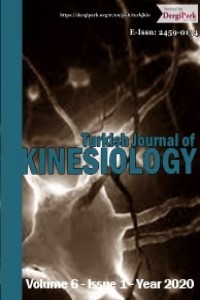Anthropological profile of long jumpers: Differences between Olympic games finalists
Anthropological profile of long jumpers: Differences between Olympic games finalists
The study included a sample of 48 male and female Olympic finalists (Beijing, 2008; London, 2012; Rio de Janeiro, 2016) in the long jump discipline. The following primary parameters of anthropological status (Body height, Body mass, Body Mass Index, Age) and Result (secondary parameter) were analyzed. The aim of the study was to determine the differences in the defined parameters of anthropological status (body height, body weight, BMI, and age) between male and female long jump finalists. The basic central and dispersion indicators were calculated on the basis of which a descriptive comparison of the analyzed variables was performed. The significance of the difference between subjects was examined by MANOVA and ANOVA (p<0.05). The results showed statistically significant differences in mean values of body height in men where the jumpers in Beijing (180,25cm) were lower than the jumpers in London (186.88cm) for level (p<0.05). There were significant differences in height among women, the female athletes in Beijing (175.50cm) were more than the female athletes from Rio (Rio, 169cm), for level (p<0.05). Numerical differences were also recorded for other parameters, but the expected statistical significance was not achievable. It has been shown that anthropometric parameters are relative and not primary. Preference is given to the motor and functional parameters of jumpers.
Keywords:
Anthropological status, differences long jump, Olympic games,
___
- Azuma, A., Maezawa, K., & Kawakami, H. (2000). Body composition, physical fitness, and jumping reaction time of Japanese middle-aged women. Bulletin of Hokuriku Society of Physical Education, Health and Sport Sciences, 36, 37-43.
- Azuma, A., Matsui, K. (2021). Relationship between jump distance for running long jump and physical characteristics of male students in PE class. Advances in Physical Education, 11, 232-238.
- Ćuk, I., & Rakić, S. (2019). Osnove atletike, teorija i metodika [Fundamentals of athletics, theory and methodic. In Serbian] Univerzitet Singidunum, Beograd.
- Fukashiro, S. (1983). Hashirihabatobi to Sandantobi no Biomechanics (Biomechanics in Running Long Jump and Triple Jump). Japanese Journal of Sports Sciences, 2, 600-613. [In Japanese]
- IAAF. (2022) Athletes. Retrieved April 01, 2022, from https:// www.worldathletics.org/athletes.
- Idrizović, K. (2010). Atletika I i II. [Atheltics I, II. In Serbian]. Univerzitet Crne Gore: Biblioteka biomedicinskih nauka.
- Jovović, V. (2006). Atletika biomehanika-tehnika i metodika [Athletics biomechanics-technique and methodics]. Nikšić. Filozofski fakultet-studijski program fizičke kulture.
- Lee, A., Fowler, N., & Derby, D. (1994). A biomechanical analysis of the last stride, touchdown, and takeoff characteristics of the men’s long jump. J Appl Biomech, 10, 61-78.
- Ljubičić, S., Uzelac, I., Šciran, T., & Dukarić, V. (2017). Differences in morphological characteristics of finalist jumpers at the 2000-2012 Olympic Games] U Zborniku (Ur.), G.Leko, V.Findak, 26 Ljetna škola kineziologa Republike Hrvatske “Kineziološke Kompetencije U Područjima Edukacije Sporta, Sportske Rekreacije i Kineziterapije”, (157-162).Hrvatski kineziološki savez.
- Mihajlović, I. (2010). Atletika. [Athletics-textbook] Novi Sad: Fakultet sporta i fizičkog vaspitanja.
- Miyatake, N., Miyauchi, M., Nishikawa, H., Saito, T., & Numata, T. (2007). Comparison of Whole Body Reaction Time between Japanese Men with and without Metabolic Syndrome. International Journal of Sports Health and Science, 5, 122-124.
- Pavlović, R. (2012). The morphological status of the finalist in jumping disciplines at the Beijing Olympics. Sport Science- International Scientific Journal on Kinesiology, 5(2), 43-48.
- Pavlović, R. (2013). Morphological status of female finalists in jumping disciplines at the Beijing Olympics. Sport Mont, 11(37-39), 116-125.
- Pavlović, R. (2014). Differences in morphological characteristics of female athletics jumpers finalists of the Beijing Olympics. Sports Sciences and Health, 9(2), 146-158.
- Pavlović, R. (2016). Atletika 2 [Athletics 2-textbook] Udruženje književnika “Branko Miljković”, Niš.
- Pavlović, R., Idrizović, K., Kinov, S., & Joksimović, M. (2016). The differences of kinematic parameters long jump between finalists World Championship in athletics (Berlin, 2009 - Daegu, 2011). Slovak Journal of Sport Science, 1 (2), 64-81.
- Pavlović, R., Petrović, B., Pupiš, M., & Bendikova, E. (2020). Differences of results between women’s and between men’s finalists in the running, jumping and throwing disciplines of the finalists of the world championships. American Journal of Sports Science and Medicine, 8 (2), 60-68.
- Pavlović, R., Radić, Z., Simeonov, A., Idrizović, K., Raković, A., & Tošić, J. (2013). Differences in anthropological space of jumpers finalists of the Beijing olympics. Research in Physical Education, Sport and Health, 2(2), 63-71.
- Smajlović, N. (2010). Atletika [Athletics-textbook. In Serbian]. Sarajevo: Fakultet sporta i tjelesnog odgoja.
- Stanković, D., & Raković, A. (2010). Atletika [Athletics-textbook. In Serbian]. Niš: Fakultet sporta i fizičkog vaspitanja.
- Tončev, I. (2001). Atletika-tehnika i obučavanje [Athletics-technique and training-textbook. In Serbian] Novi Sad: Fakultet fizičke kulture.
- Ugarković, D. (1996). Biology of human development with the basics of sports medicine. Belgrade: Faculty of Physical Education and Sport.
- Başlangıç: 2015
- Yayıncı: Nurtekin Erkmen
Sayıdaki Diğer Makaleler
Anthropological profile of long jumpers: Differences between Olympic games finalists
Concept of sports training periodization for better performance: A critical discussion
Physical match performance and creatine kinase levels in elite football players
